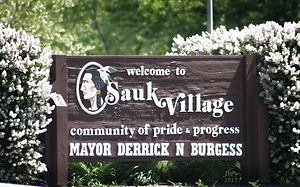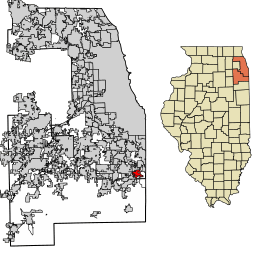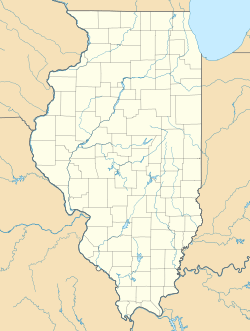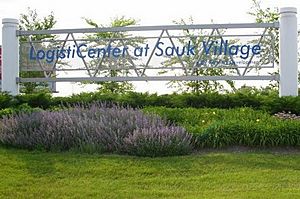Sauk Village, Illinois facts for kids
Quick facts for kids
Sauk Village, Illinois
|
||
|---|---|---|
 |
||
|
||
| Nickname(s):
"The Village"
|
||
| Motto(s):
Pride and Progress
|
||

Location of Sauk Village in Cook County, Illinois.
|
||
| Country | United States | |
| State | Illinois | |
| Counties | Cook, Will | |
| Township | Bloom | |
| Founded | 1842 (Incorporated on March 12, 1957) | |
| Government | ||
| • Type | Mayor (Village President) and Village Board of Trustees | |
| Area | ||
| • Total | 4.00 sq mi (10.35 km2) | |
| • Land | 3.99 sq mi (10.34 km2) | |
| • Water | 0.00 sq mi (0.01 km2) | |
| Population
(2020)
|
||
| • Total | 9,921 | |
| • Density | 2,485.22/sq mi (959.56/km2) | |
| Time zone | UTC-6 (CST) | |
| • Summer (DST) | UTC-5 (CDT) | |
| ZIP Code(s) |
60411
|
|
| Area code(s) | 708 | |
| FIPS code | 17-67769 | |
Sauk Village (also known as "The Village") is a community located mostly in Cook County, Illinois, United States. A small part of it is in Will County. In 2020, about 9,921 people lived there.
Contents
Where is Sauk Village?
Sauk Village is located at 41°29′19″N 87°33′56″W / 41.48861°N 87.56556°W. It covers about 4 square miles (10.35 square kilometers) of land. Only a tiny bit is water.
The village sits on a natural ridge called the Tinley Moraine. Another old shoreline, the Glenwood Shoreline, also runs through the village.
Sauk Village is surrounded by other towns. To the northeast is Lynwood. To the north is Ford Heights. Chicago Heights is to the northwest. South Chicago Heights is to the west. Steger is to the southwest, and Crete is to the south. The town of Dyer, Indiana, is the closest community to the east.
How Many People Live Here?
| Historical population | |||
|---|---|---|---|
| Census | Pop. | %± | |
| 1960 | 4,687 | — | |
| 1970 | 7,479 | 59.6% | |
| 1980 | 10,906 | 45.8% | |
| 1990 | 9,926 | −9.0% | |
| 2000 | 10,411 | 4.9% | |
| 2010 | 10,506 | 0.9% | |
| 2020 | 9,921 | −5.6% | |
| U.S. Decennial Census 2010 2020 |
|||
In 2020, there were 9,921 people living in Sauk Village. There were 3,237 households. About 39.3% of households had children under 18. The average household had about 3.59 people.
The village is home to many different groups of people. About 68% of residents were African American, and about 16% were White. Around 13% of the population identified as Hispanic or Latino.
A Look Back: Sauk Village History
The area where Sauk Village is located has been important for hundreds of years.
Early Days and Native Americans
Long ago, Native American tribes lived on this land. It's part of a high area around Lake Michigan. Tribes like the Potawatomi and Illinois Confederation lived here. The Sauk people from Michigan used a path through here, which is why it's called the Sauk Trail. They used this high ground for trading and moving animals. As more settlers moved west in the 1800s, the Sauk tribes had to move.
First Settlers and Strassburg
American settlers first arrived in 1830. The land officially opened for settlement in 1838. In 1839, Vincent Sauter and Frederick Richards settled in what would become Sauk Village. Early settlers came from the East Coast, but their families were originally from Western Europe, especially France and Germany.
Some of the first families included Wood, Ayen, and Rowley. Later, more families like Parrino, Gatto, and Sauter moved to the area. The first postmaster, Charles Sauter, named the settlement Strassburg. He named it after Strasbourg, France, where many of the first settlers came from. Back then, land cost about $1.25 per acre.
St. Jakob's Church
In 1847, St. Jakob's Church was built. It had twenty members. The church was hit by lightning and burned down in 1871. It was rebuilt, but lightning struck again in 1873! After that, the church was moved to the corner of Sauk Trail and the Calumet Expressway. It stood there until 2004.
During World War I, in 1917, the church's name was changed from the German "St. Jakob" to "St. James." This was because of anti-German feelings at the time. During the Great Depression in the 1930s, people helped the church by digging out its basement by hand. This created a hall that could be rented to earn money.
In 1940, a tornado damaged the church's roof. The old St. James Church was also known as the Old Community Center. The cemetery behind it, St. James Cemetery at Strassburg, is where many of Sauk Village's first settlers are buried. Today, the original bell from the 1800s stands outside the current St. James Church.
Becoming Sauk Village
When the Calumet Expressway was built in the late 1950s, the Strassburg area became a good place for new homes. In 1956, a company called AMBO I Construction started building houses. This area is now known as the Garden Section.
The community officially became a village on March 12, 1957. It was named Sauk Village because another town in southern Illinois was already called Strasburg. Thomas J. Nichols was the first president (mayor) of Sauk Village.
Growth and Development
Since 1957, Sauk Village has grown a lot. By 1961, there were 1,258 homes and 5,774 residents. New schools like Strassburg and Cynthia Street (now Wagoner) were built.
In the 1970s, more development happened. Rickover Junior High School opened in 1970. New neighborhoods and shopping areas like Surreybrook Plaza were built. In 1977, the Village Hall and Police Station moved to a new building on Torrence Avenue.
The village continued to expand in the early 1980s with more homes and new subdivisions. The Community Center opened in 1982, celebrating the village's 25th anniversary. In the late 1980s, the Sauk Pointe Industrial Park began. Pacesetter Steel was the first company to move there in 1988.
The 1990s brought more growth. Carolina Freight opened in 1990, creating many jobs. In 1993, the Carolina Subdivision started building new homes. The population grew from 9,704 in 1990 to about 10,411 in 2000.
In 2007, plans were made for a new Village Hall and Senior Citizen Center. Construction began in August 2007, at the same time as the village's 50th anniversary. The new Village Hall opened on November 1, 2008. It is a modern building that cost $5 million. The old Village Hall became the Police Department.
In 2012, voters decided to stop using well water and instead get water from Lake Michigan. This was part of a plan to improve the water system.
McConathy Public Library
The library in Sauk Village started with volunteers. It was in the basement of Katz Corner School. In 1973, people voted to create the Sauk Village Library District, which officially formed in 1974.
The library grew and moved to a house, then to a storefront in Surreybrook Plaza. In 1986, the library was renamed the Nancy L. McConathy Public Library District. This was to honor Nancy L. McConathy, a library trustee and Village Clerk who had passed away.
In 2006, the library moved into its very own building at 21737 Jeffery Avenue. This was a big step for the library and the community.
Village Elections
Elections in Sauk Village happen every two years in early April. Both the Mayor and Village Trustees are elected every four years.
Mayors of Sauk Village
Recent Elections
- 2009 Mayoral Election: Lewis Towers was elected mayor. He was the first African-American mayor and the first to win running with a political party.
- 2011 Election: David Hanks was re-elected as Village Trustee for a fourth time. Derrick Burgess and Robert Chavez also won. Robert Chavez was the first Hispanic/Latino Village Trustee elected.
- 2013 Mayoral Election: Mayor Lewis Towers resigned in November 2012. The Village Board chose David Hanks to be the acting mayor. Hanks later decided to run for mayor and won the election in April 2013.
- 2015 Election: Derrick Burgess was elected to his third term as Trustee. Cecial Tates and Kelvin Jones were also elected. This election was notable because two current Trustees were not re-elected, which hadn't happened since 1971.
- 2017 Mayoral Election: David Hanks decided not to run again. Village Trustee Derrick Burgess ran for mayor and won with 55% of the votes. He became the 8th Mayor of Sauk Village. Marva Campbell-Pruitt was elected Village Clerk, becoming the first African-American elected Village Clerk.
- 2019 Election: One Trustee seat was decided by a coin flip because two candidates, Beth Zupon and Gary T. Bell, had the same number of votes. Gary T. Bell won the coin flip.
- 2021 Mayoral Election: Derrick Burgess was re-elected for his second term as mayor with 53% of the votes.
- 2023 Election: All Trustees elected in this election won without opposition.
Development and Future Growth
Sauk Village grew a lot in the early 1990s when it added nearly 1 square mile of land. This was a big expansion, similar to the growth when the village first started. In 1991, a large 500-acre area was added to the village. This land was once considered for a GM-Saturn car plant or a new Chicago Bears Stadium.
In 2004, Sauk Village began working with a company called DP Partners to develop this land. They plan to spend $150 million to build 5 million square feet of warehouses and manufacturing spaces. The LogistiCenter Business Park now covers 325 acres and has a large distribution center.
In 2011, Winpak, a packaging company, bought land in the LogistiCenter. They built a large facility and expanded it in 2016. Thanks to help from the State of Illinois and other groups, Winpak stayed in Sauk Village.
In 2017, Sauk Village sold 32 acres of land for a new commercial development. Gas-N-Wash opened in 2019. This was the first major commercial project in over 30 years for the village. It includes a large convenience store, restaurants, and a truck stop.
Notable People from Sauk Village
- Jeff Allen - An actor and Christian comedian.
- Cory Hardrict - An American actor who has been in films and TV shows since the late 1990s.
- Jan Johnson - A former American athlete known for pole vaulting. He graduated from the University of Alabama in 1972. The gymnasium at Rickover Junior High School in Sauk Village is named in his honor.
Images for kids
See also
 In Spanish: Sauk Village para niños
In Spanish: Sauk Village para niños












